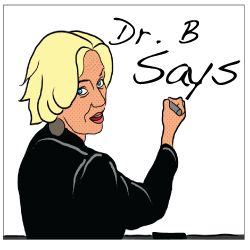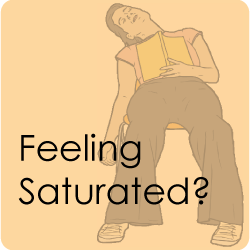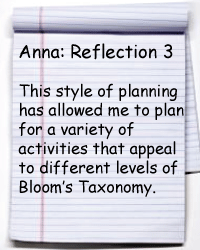 Bloom's Taxonomy
Bloom's Taxonomy
 Planning is more than a process of listing necessary steps to complete an activity or task. As Anna progresses through her APT, for instance, she is discovering the importance of incorporating different theories in her planning and implementation including Bloom’s Taxonomy, a type of classification of the different objectives that educators might set for students. Teachers want to insure that their lessons are varied and that they encourage thinking at different levels of the taxonomy- ranging from recitation and labeling to reconstructing and summarizing. In order to better understand Bloom’s Taxonomy and how we can successfully apply it to our planning, let’s look at how the taxonomies are organized and how these theories can be used in language teaching. Planning is more than a process of listing necessary steps to complete an activity or task. As Anna progresses through her APT, for instance, she is discovering the importance of incorporating different theories in her planning and implementation including Bloom’s Taxonomy, a type of classification of the different objectives that educators might set for students. Teachers want to insure that their lessons are varied and that they encourage thinking at different levels of the taxonomy- ranging from recitation and labeling to reconstructing and summarizing. In order to better understand Bloom’s Taxonomy and how we can successfully apply it to our planning, let’s look at how the taxonomies are organized and how these theories can be used in language teaching. |
back to...Anna's case study |
What is Bloom’s Taxonomy?
Western education systems often describe the outcomes they expect from students as knowledge, skills and attitudes – KSAs. Knowledge refers to mental skills or the cognitive domain of learning. Skills refers to the psychomotor or manual skills that need to be developed by school aged members of society. Attitudes are the growth in affective or emotional areas. The origins of the KSAs can be traced back to the research of Benjamin Bloom and his colleagues in the 1950s.
The most important domains to consider in regards to second language education are the cognitive and affective. Each domain is made up of parts or sub-domains, starting from the simplest behavior to the most complex.
What do the Cognitive and Affective Taxonomies involve?
BLOOM’s COGNITIVE TAXONOMY
Bloom's cognitive taxonomy is organized into six sub-domains, each more cognitively demanding than the next. These six sub-domains are:
Sub-domain |
Examples |
Key Words |
Knowledge: |
Recite a policy. Quote prices from memory to a customer. |
defines, describes, identifies, knows, labels, lists, matches, names, outlines, recalls, recognizes, reproduces, selects, states. |
Comprehension: |
Rewrites the principles of test writing. Explain in one’s own words the steps for performing a complex task. |
comprehends, converts, defends, distinguishes, estimates, explains, extends, generalizes, gives examples, infers, interprets, paraphrases, predicts, rewrites, summarizes, translates. |
Application: |
Use a manual to calculate an employee’s vacation time. Apply laws of statistics to evaluate the reliability of a written test. |
applies, changes, computes, constructs, demonstrates, discovers, manipulates, modifies, operates, predicts, prepares, produces, relates, shows, solves, uses. |
Analysis: |
Troubleshoot a piece of equipment by using logical deduction. Recognize logical fallacies in reasoning. |
analyzes, breaks down, compares, contrasts, diagrams, deconstructs, differentiates, discriminates, distinguishes, identifies, illustrates, infers, outlines, relates, selects, separates. |
Synthesis: |
Write a company operations or process manual. Design a machine to perform a specific task. Integrates training from several sources to solve a problem. |
categorizes, combines, compiles, composes, creates, devises, designs, explains, generates, modifies, organizes, plans, rearranges, reconstructs, relates, reorganizes, revises, rewrites, summarizes, tells, writes. |
Evaluation: |
Select the most effective solution. Hire the most qualified candidate. Explain and justify a new budget. |
appraises, compares, concludes, contrasts, criticizes, critiques, defends, describes, discriminates, evaluates, explains, interprets, justifies, relates, summarizes, supports. |
back to top
BLOOM’s AFFECTIVE TAXONOMY
This domain focuses on the manner in which we deal with things emotionally, such as feelings, values, appreciation, enthusiasms, motivations, and attitudes. The five major categories listed in order are:
Receiving phenomena
Responding to phenomena
Valuing
Organization
Internalizing values
To read more about Bloom's Affective Taxonomy click here.
How does Bloom’s Taxonomy apply to Language teaching?
Language teachers should consider Bloom’s Taxonomy during multiple stages of the B-SLIM model. Teachers need to consider how material can be scaffolded in a way that reflects Bloom’s Taxonomy. In the second language learning context, learners must engage in a lot of knowledge and comprehension in their beginning stages of SL learning. As learners become more competent, activities should focus more on higher levels of thinking which are always more interesting to learners!
This chart shows some sample outcomes and 'I can statements' that can be done at each level of the taxonomy for a Food Unit in the language classroom.
Level |
Example of outcome. |
I can statement. |
Knowledge |
Students can name specific terminology or specific facts. |
I can name all of the fruits and vegetables. |
Comprehension |
Students can interpret information by rearranging the material by order of significance. |
I can categorize the fruits and vegetables into groups. |
Application |
Students can apply what has been learned to other situations and learning tasks. |
I can make a list of groceries needed for a salad. |
Analysis |
Students can break down material into part and determine connection and interaction between parts. |
I can read and prepare a simple recipe. |
Synthesis |
Students can produce a plan or solution to a particular situation and originate a product that follows their original thoughts or ideas. |
I can plan and produce a cooking show. |
Evaluation |
Students can apply known criteria to judge situations or conditions that they encounter. |
I can compare and evaluate two recipes for nutritional value. |
 |
Choose a topic that you may teach in your subject (i.e. clothing, transport, travel, family) and create one 'I can statement' for each level of Bloom's Taxonomy. |
back to top

 Applying Bloom’s Taxonomy
Applying Bloom’s Taxonomy
http://www.teachers.ash.org.au/researchskills/dalton.htm
Bloom's Taxonomy of Learning Domains: The Three Types of Learning
http://www.nwlink.com/~donclark/hrd/bloom.html



